Exploring the Dynamics of Organizational Communication in HRM
VerifiedAdded on 2023/06/12
|7
|1891
|163
Essay
AI Summary
This essay critically discusses organizational communication, defining it as the flow of information, ideas, and emotions within an organization, both formally and informally. It emphasizes that effective communication enhances productivity and aids in achieving organizational goals, especially in multicultural environments. The essay highlights that communication is not solely the responsibility of managers but involves all employees, with the interpretation of messages playing a crucial role. It explores the impact of organizational talk, including linguistic artifacts like labels, metaphors, and platitudes, on brand equity and managerial philosophy. The analysis further examines the role of gossips, both positive and negative, in influencing power dynamics and employee behavior. It also addresses the influence of technology on internal communication and the challenges posed by noises that distort information flow, ultimately affecting the power of both managers and gossipers. The essay concludes by advocating for regulations to prevent harmful gossips and the use of modern communication technologies to minimize information distortion.
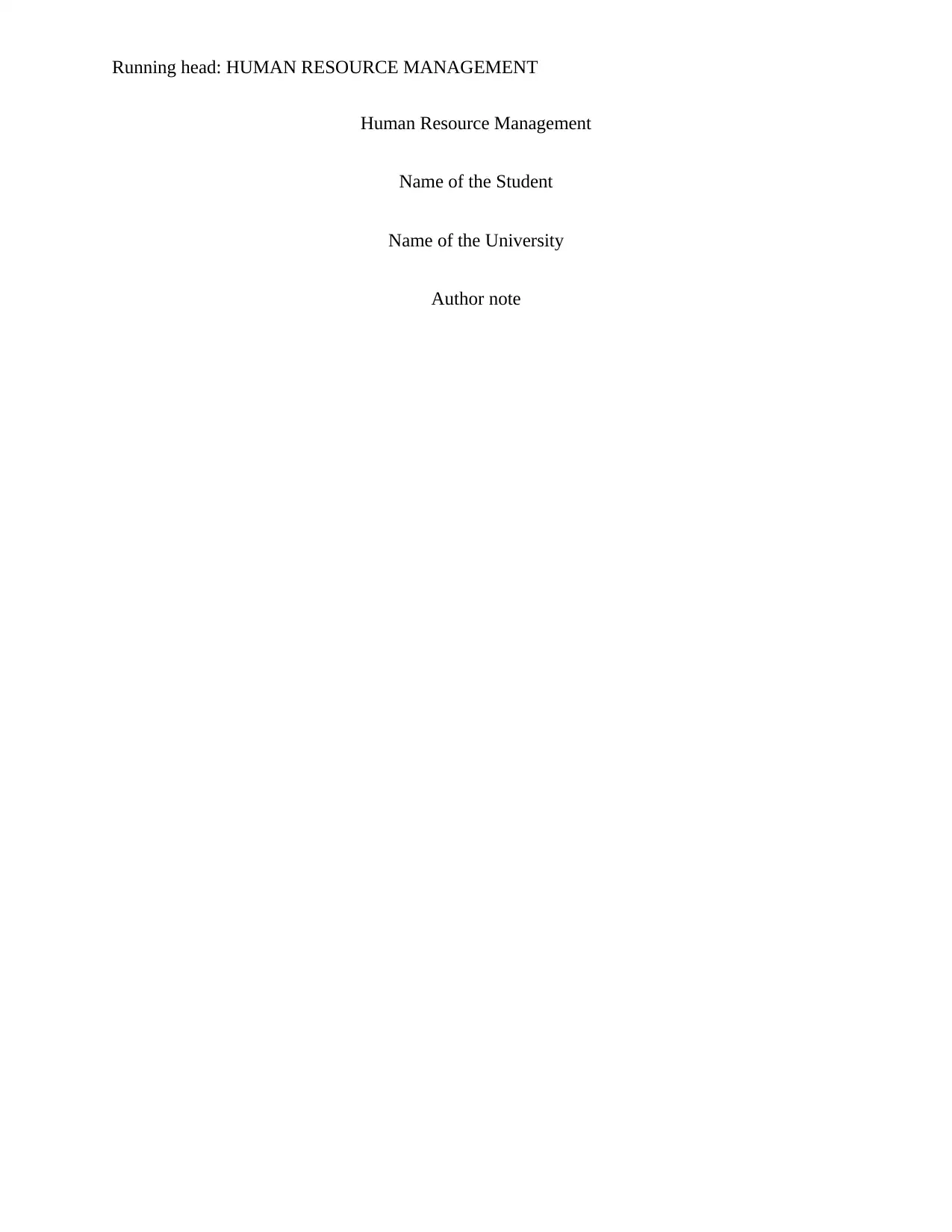
Running head: HUMAN RESOURCE MANAGEMENT
Human Resource Management
Name of the Student
Name of the University
Author note
Human Resource Management
Name of the Student
Name of the University
Author note
Paraphrase This Document
Need a fresh take? Get an instant paraphrase of this document with our AI Paraphraser
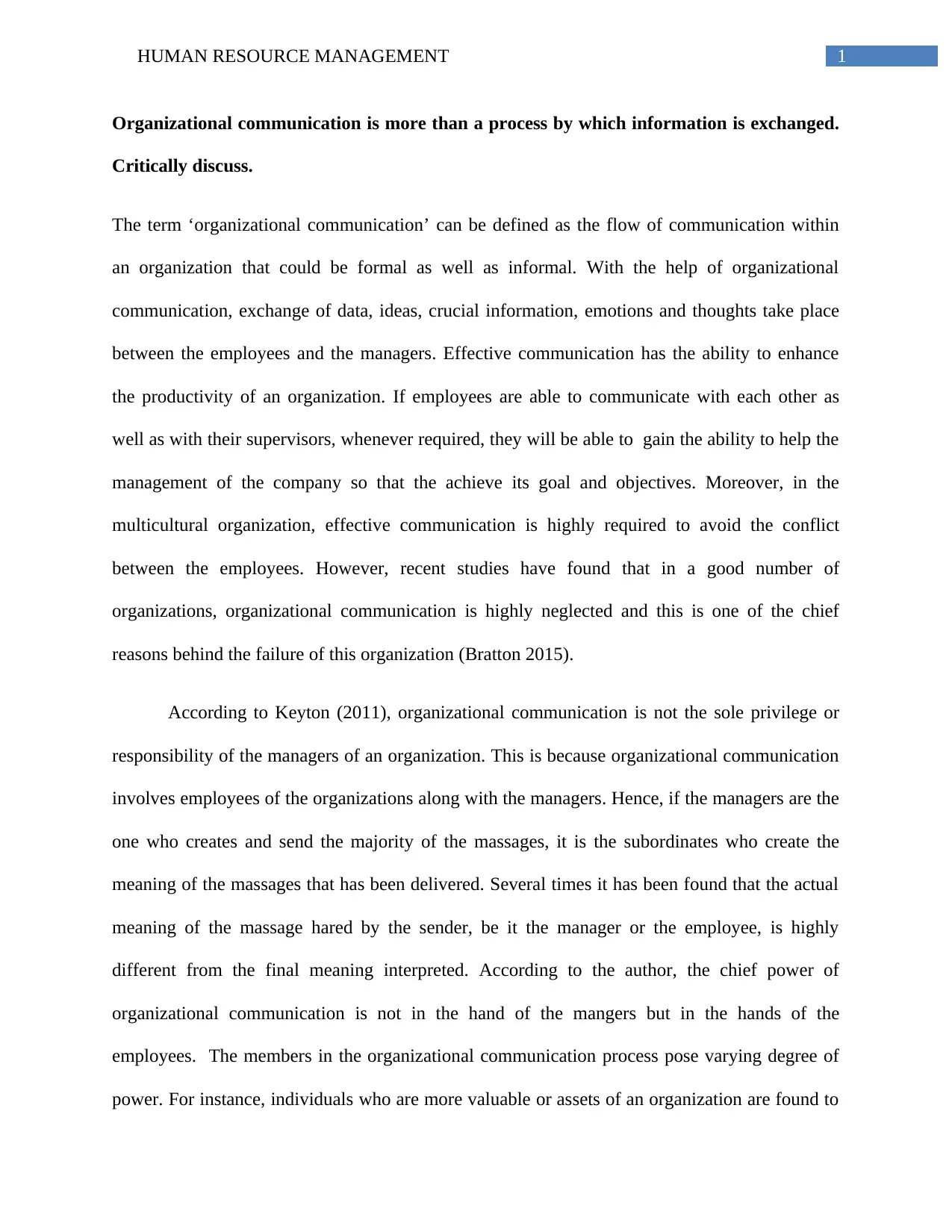
1HUMAN RESOURCE MANAGEMENT
Organizational communication is more than a process by which information is exchanged.
Critically discuss.
The term ‘organizational communication’ can be defined as the flow of communication within
an organization that could be formal as well as informal. With the help of organizational
communication, exchange of data, ideas, crucial information, emotions and thoughts take place
between the employees and the managers. Effective communication has the ability to enhance
the productivity of an organization. If employees are able to communicate with each other as
well as with their supervisors, whenever required, they will be able to gain the ability to help the
management of the company so that the achieve its goal and objectives. Moreover, in the
multicultural organization, effective communication is highly required to avoid the conflict
between the employees. However, recent studies have found that in a good number of
organizations, organizational communication is highly neglected and this is one of the chief
reasons behind the failure of this organization (Bratton 2015).
According to Keyton (2011), organizational communication is not the sole privilege or
responsibility of the managers of an organization. This is because organizational communication
involves employees of the organizations along with the managers. Hence, if the managers are the
one who creates and send the majority of the massages, it is the subordinates who create the
meaning of the massages that has been delivered. Several times it has been found that the actual
meaning of the massage hared by the sender, be it the manager or the employee, is highly
different from the final meaning interpreted. According to the author, the chief power of
organizational communication is not in the hand of the mangers but in the hands of the
employees. The members in the organizational communication process pose varying degree of
power. For instance, individuals who are more valuable or assets of an organization are found to
Organizational communication is more than a process by which information is exchanged.
Critically discuss.
The term ‘organizational communication’ can be defined as the flow of communication within
an organization that could be formal as well as informal. With the help of organizational
communication, exchange of data, ideas, crucial information, emotions and thoughts take place
between the employees and the managers. Effective communication has the ability to enhance
the productivity of an organization. If employees are able to communicate with each other as
well as with their supervisors, whenever required, they will be able to gain the ability to help the
management of the company so that the achieve its goal and objectives. Moreover, in the
multicultural organization, effective communication is highly required to avoid the conflict
between the employees. However, recent studies have found that in a good number of
organizations, organizational communication is highly neglected and this is one of the chief
reasons behind the failure of this organization (Bratton 2015).
According to Keyton (2011), organizational communication is not the sole privilege or
responsibility of the managers of an organization. This is because organizational communication
involves employees of the organizations along with the managers. Hence, if the managers are the
one who creates and send the majority of the massages, it is the subordinates who create the
meaning of the massages that has been delivered. Several times it has been found that the actual
meaning of the massage hared by the sender, be it the manager or the employee, is highly
different from the final meaning interpreted. According to the author, the chief power of
organizational communication is not in the hand of the mangers but in the hands of the
employees. The members in the organizational communication process pose varying degree of
power. For instance, individuals who are more valuable or assets of an organization are found to
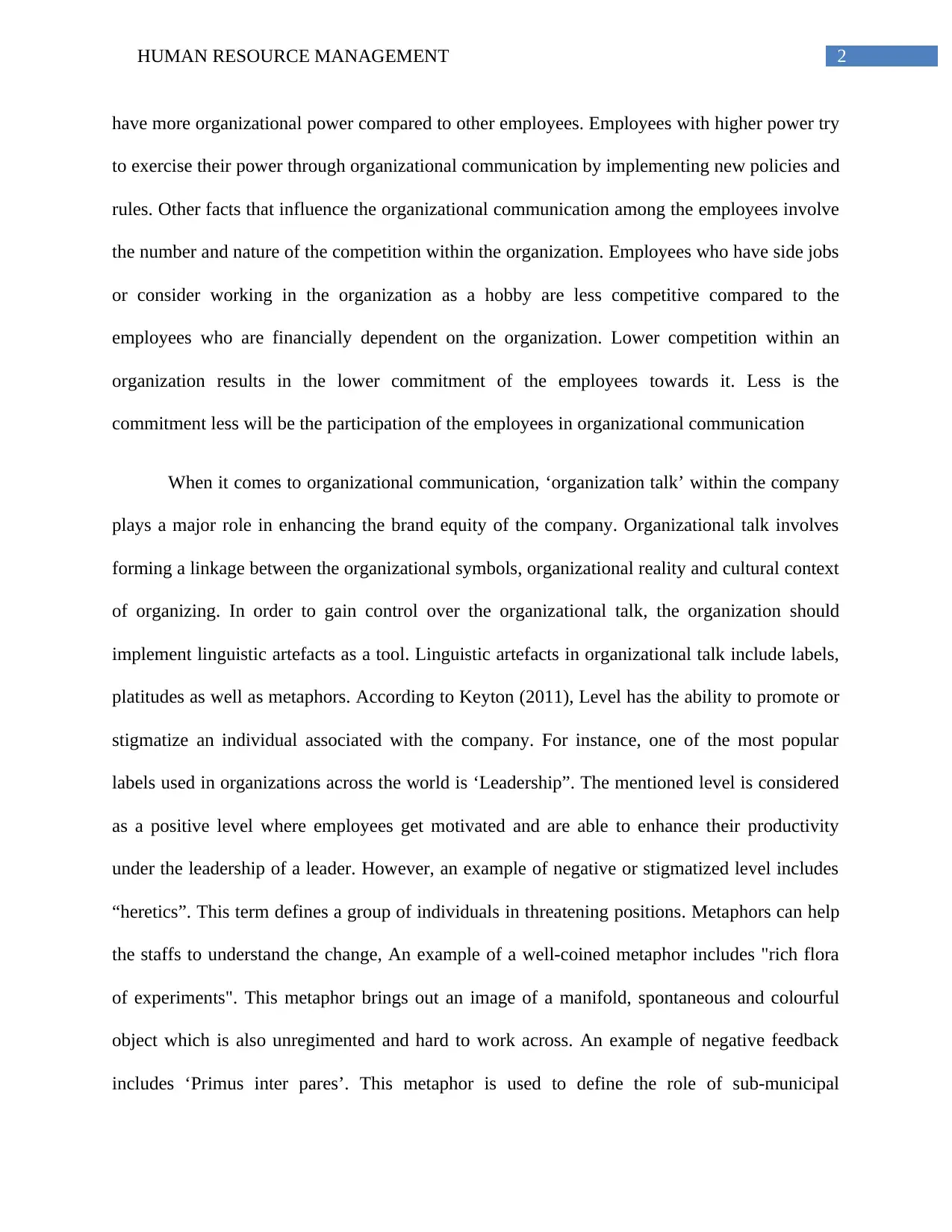
2HUMAN RESOURCE MANAGEMENT
have more organizational power compared to other employees. Employees with higher power try
to exercise their power through organizational communication by implementing new policies and
rules. Other facts that influence the organizational communication among the employees involve
the number and nature of the competition within the organization. Employees who have side jobs
or consider working in the organization as a hobby are less competitive compared to the
employees who are financially dependent on the organization. Lower competition within an
organization results in the lower commitment of the employees towards it. Less is the
commitment less will be the participation of the employees in organizational communication
When it comes to organizational communication, ‘organization talk’ within the company
plays a major role in enhancing the brand equity of the company. Organizational talk involves
forming a linkage between the organizational symbols, organizational reality and cultural context
of organizing. In order to gain control over the organizational talk, the organization should
implement linguistic artefacts as a tool. Linguistic artefacts in organizational talk include labels,
platitudes as well as metaphors. According to Keyton (2011), Level has the ability to promote or
stigmatize an individual associated with the company. For instance, one of the most popular
labels used in organizations across the world is ‘Leadership”. The mentioned level is considered
as a positive level where employees get motivated and are able to enhance their productivity
under the leadership of a leader. However, an example of negative or stigmatized level includes
“heretics”. This term defines a group of individuals in threatening positions. Metaphors can help
the staffs to understand the change, An example of a well-coined metaphor includes "rich flora
of experiments". This metaphor brings out an image of a manifold, spontaneous and colourful
object which is also unregimented and hard to work across. An example of negative feedback
includes ‘Primus inter pares’. This metaphor is used to define the role of sub-municipal
have more organizational power compared to other employees. Employees with higher power try
to exercise their power through organizational communication by implementing new policies and
rules. Other facts that influence the organizational communication among the employees involve
the number and nature of the competition within the organization. Employees who have side jobs
or consider working in the organization as a hobby are less competitive compared to the
employees who are financially dependent on the organization. Lower competition within an
organization results in the lower commitment of the employees towards it. Less is the
commitment less will be the participation of the employees in organizational communication
When it comes to organizational communication, ‘organization talk’ within the company
plays a major role in enhancing the brand equity of the company. Organizational talk involves
forming a linkage between the organizational symbols, organizational reality and cultural context
of organizing. In order to gain control over the organizational talk, the organization should
implement linguistic artefacts as a tool. Linguistic artefacts in organizational talk include labels,
platitudes as well as metaphors. According to Keyton (2011), Level has the ability to promote or
stigmatize an individual associated with the company. For instance, one of the most popular
labels used in organizations across the world is ‘Leadership”. The mentioned level is considered
as a positive level where employees get motivated and are able to enhance their productivity
under the leadership of a leader. However, an example of negative or stigmatized level includes
“heretics”. This term defines a group of individuals in threatening positions. Metaphors can help
the staffs to understand the change, An example of a well-coined metaphor includes "rich flora
of experiments". This metaphor brings out an image of a manifold, spontaneous and colourful
object which is also unregimented and hard to work across. An example of negative feedback
includes ‘Primus inter pares’. This metaphor is used to define the role of sub-municipal
⊘ This is a preview!⊘
Do you want full access?
Subscribe today to unlock all pages.

Trusted by 1+ million students worldwide
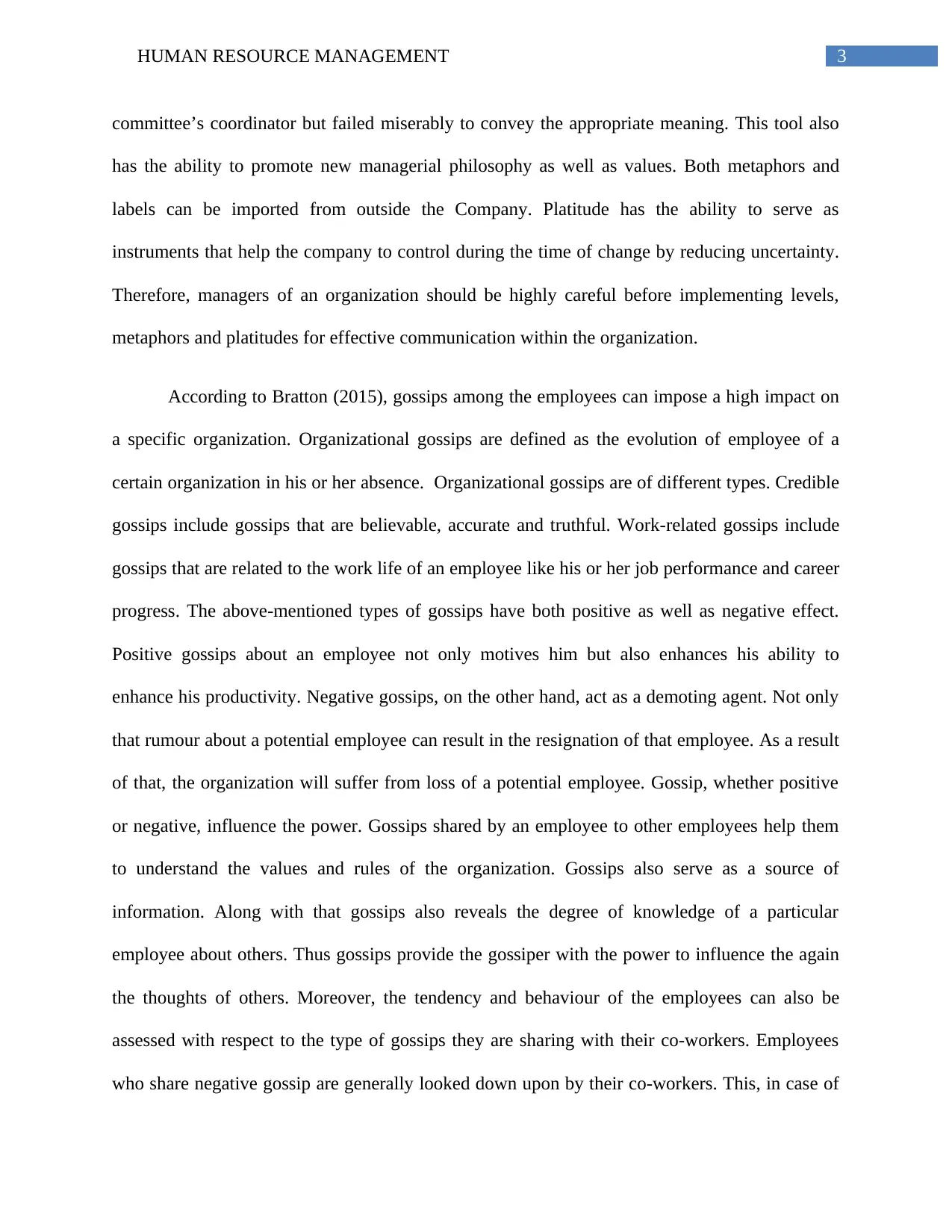
3HUMAN RESOURCE MANAGEMENT
committee’s coordinator but failed miserably to convey the appropriate meaning. This tool also
has the ability to promote new managerial philosophy as well as values. Both metaphors and
labels can be imported from outside the Company. Platitude has the ability to serve as
instruments that help the company to control during the time of change by reducing uncertainty.
Therefore, managers of an organization should be highly careful before implementing levels,
metaphors and platitudes for effective communication within the organization.
According to Bratton (2015), gossips among the employees can impose a high impact on
a specific organization. Organizational gossips are defined as the evolution of employee of a
certain organization in his or her absence. Organizational gossips are of different types. Credible
gossips include gossips that are believable, accurate and truthful. Work-related gossips include
gossips that are related to the work life of an employee like his or her job performance and career
progress. The above-mentioned types of gossips have both positive as well as negative effect.
Positive gossips about an employee not only motives him but also enhances his ability to
enhance his productivity. Negative gossips, on the other hand, act as a demoting agent. Not only
that rumour about a potential employee can result in the resignation of that employee. As a result
of that, the organization will suffer from loss of a potential employee. Gossip, whether positive
or negative, influence the power. Gossips shared by an employee to other employees help them
to understand the values and rules of the organization. Gossips also serve as a source of
information. Along with that gossips also reveals the degree of knowledge of a particular
employee about others. Thus gossips provide the gossiper with the power to influence the again
the thoughts of others. Moreover, the tendency and behaviour of the employees can also be
assessed with respect to the type of gossips they are sharing with their co-workers. Employees
who share negative gossip are generally looked down upon by their co-workers. This, in case of
committee’s coordinator but failed miserably to convey the appropriate meaning. This tool also
has the ability to promote new managerial philosophy as well as values. Both metaphors and
labels can be imported from outside the Company. Platitude has the ability to serve as
instruments that help the company to control during the time of change by reducing uncertainty.
Therefore, managers of an organization should be highly careful before implementing levels,
metaphors and platitudes for effective communication within the organization.
According to Bratton (2015), gossips among the employees can impose a high impact on
a specific organization. Organizational gossips are defined as the evolution of employee of a
certain organization in his or her absence. Organizational gossips are of different types. Credible
gossips include gossips that are believable, accurate and truthful. Work-related gossips include
gossips that are related to the work life of an employee like his or her job performance and career
progress. The above-mentioned types of gossips have both positive as well as negative effect.
Positive gossips about an employee not only motives him but also enhances his ability to
enhance his productivity. Negative gossips, on the other hand, act as a demoting agent. Not only
that rumour about a potential employee can result in the resignation of that employee. As a result
of that, the organization will suffer from loss of a potential employee. Gossip, whether positive
or negative, influence the power. Gossips shared by an employee to other employees help them
to understand the values and rules of the organization. Gossips also serve as a source of
information. Along with that gossips also reveals the degree of knowledge of a particular
employee about others. Thus gossips provide the gossiper with the power to influence the again
the thoughts of others. Moreover, the tendency and behaviour of the employees can also be
assessed with respect to the type of gossips they are sharing with their co-workers. Employees
who share negative gossip are generally looked down upon by their co-workers. This, in case of
Paraphrase This Document
Need a fresh take? Get an instant paraphrase of this document with our AI Paraphraser
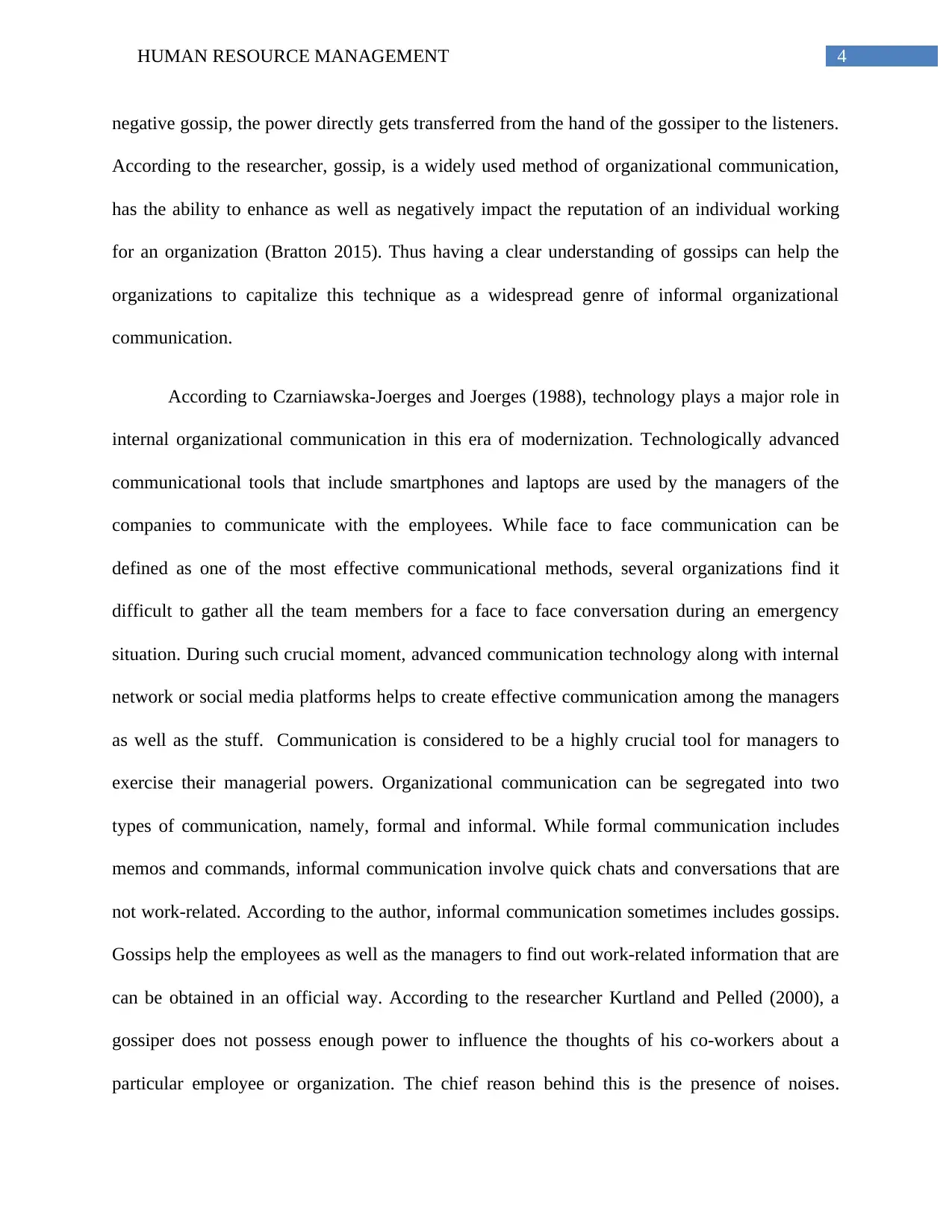
4HUMAN RESOURCE MANAGEMENT
negative gossip, the power directly gets transferred from the hand of the gossiper to the listeners.
According to the researcher, gossip, is a widely used method of organizational communication,
has the ability to enhance as well as negatively impact the reputation of an individual working
for an organization (Bratton 2015). Thus having a clear understanding of gossips can help the
organizations to capitalize this technique as a widespread genre of informal organizational
communication.
According to Czarniawska-Joerges and Joerges (1988), technology plays a major role in
internal organizational communication in this era of modernization. Technologically advanced
communicational tools that include smartphones and laptops are used by the managers of the
companies to communicate with the employees. While face to face communication can be
defined as one of the most effective communicational methods, several organizations find it
difficult to gather all the team members for a face to face conversation during an emergency
situation. During such crucial moment, advanced communication technology along with internal
network or social media platforms helps to create effective communication among the managers
as well as the stuff. Communication is considered to be a highly crucial tool for managers to
exercise their managerial powers. Organizational communication can be segregated into two
types of communication, namely, formal and informal. While formal communication includes
memos and commands, informal communication involve quick chats and conversations that are
not work-related. According to the author, informal communication sometimes includes gossips.
Gossips help the employees as well as the managers to find out work-related information that are
can be obtained in an official way. According to the researcher Kurtland and Pelled (2000), a
gossiper does not possess enough power to influence the thoughts of his co-workers about a
particular employee or organization. The chief reason behind this is the presence of noises.
negative gossip, the power directly gets transferred from the hand of the gossiper to the listeners.
According to the researcher, gossip, is a widely used method of organizational communication,
has the ability to enhance as well as negatively impact the reputation of an individual working
for an organization (Bratton 2015). Thus having a clear understanding of gossips can help the
organizations to capitalize this technique as a widespread genre of informal organizational
communication.
According to Czarniawska-Joerges and Joerges (1988), technology plays a major role in
internal organizational communication in this era of modernization. Technologically advanced
communicational tools that include smartphones and laptops are used by the managers of the
companies to communicate with the employees. While face to face communication can be
defined as one of the most effective communicational methods, several organizations find it
difficult to gather all the team members for a face to face conversation during an emergency
situation. During such crucial moment, advanced communication technology along with internal
network or social media platforms helps to create effective communication among the managers
as well as the stuff. Communication is considered to be a highly crucial tool for managers to
exercise their managerial powers. Organizational communication can be segregated into two
types of communication, namely, formal and informal. While formal communication includes
memos and commands, informal communication involve quick chats and conversations that are
not work-related. According to the author, informal communication sometimes includes gossips.
Gossips help the employees as well as the managers to find out work-related information that are
can be obtained in an official way. According to the researcher Kurtland and Pelled (2000), a
gossiper does not possess enough power to influence the thoughts of his co-workers about a
particular employee or organization. The chief reason behind this is the presence of noises.
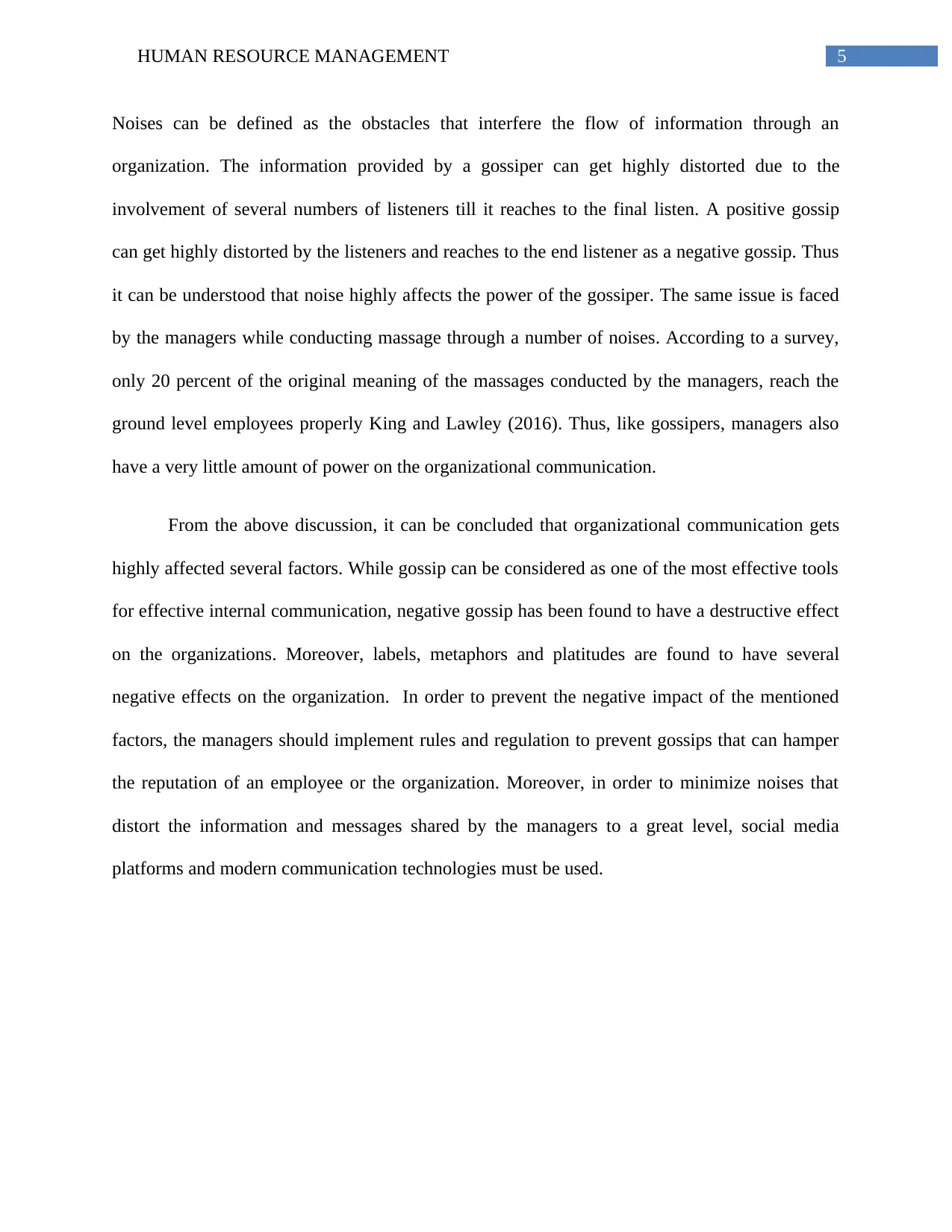
5HUMAN RESOURCE MANAGEMENT
Noises can be defined as the obstacles that interfere the flow of information through an
organization. The information provided by a gossiper can get highly distorted due to the
involvement of several numbers of listeners till it reaches to the final listen. A positive gossip
can get highly distorted by the listeners and reaches to the end listener as a negative gossip. Thus
it can be understood that noise highly affects the power of the gossiper. The same issue is faced
by the managers while conducting massage through a number of noises. According to a survey,
only 20 percent of the original meaning of the massages conducted by the managers, reach the
ground level employees properly King and Lawley (2016). Thus, like gossipers, managers also
have a very little amount of power on the organizational communication.
From the above discussion, it can be concluded that organizational communication gets
highly affected several factors. While gossip can be considered as one of the most effective tools
for effective internal communication, negative gossip has been found to have a destructive effect
on the organizations. Moreover, labels, metaphors and platitudes are found to have several
negative effects on the organization. In order to prevent the negative impact of the mentioned
factors, the managers should implement rules and regulation to prevent gossips that can hamper
the reputation of an employee or the organization. Moreover, in order to minimize noises that
distort the information and messages shared by the managers to a great level, social media
platforms and modern communication technologies must be used.
Noises can be defined as the obstacles that interfere the flow of information through an
organization. The information provided by a gossiper can get highly distorted due to the
involvement of several numbers of listeners till it reaches to the final listen. A positive gossip
can get highly distorted by the listeners and reaches to the end listener as a negative gossip. Thus
it can be understood that noise highly affects the power of the gossiper. The same issue is faced
by the managers while conducting massage through a number of noises. According to a survey,
only 20 percent of the original meaning of the massages conducted by the managers, reach the
ground level employees properly King and Lawley (2016). Thus, like gossipers, managers also
have a very little amount of power on the organizational communication.
From the above discussion, it can be concluded that organizational communication gets
highly affected several factors. While gossip can be considered as one of the most effective tools
for effective internal communication, negative gossip has been found to have a destructive effect
on the organizations. Moreover, labels, metaphors and platitudes are found to have several
negative effects on the organization. In order to prevent the negative impact of the mentioned
factors, the managers should implement rules and regulation to prevent gossips that can hamper
the reputation of an employee or the organization. Moreover, in order to minimize noises that
distort the information and messages shared by the managers to a great level, social media
platforms and modern communication technologies must be used.
⊘ This is a preview!⊘
Do you want full access?
Subscribe today to unlock all pages.

Trusted by 1+ million students worldwide
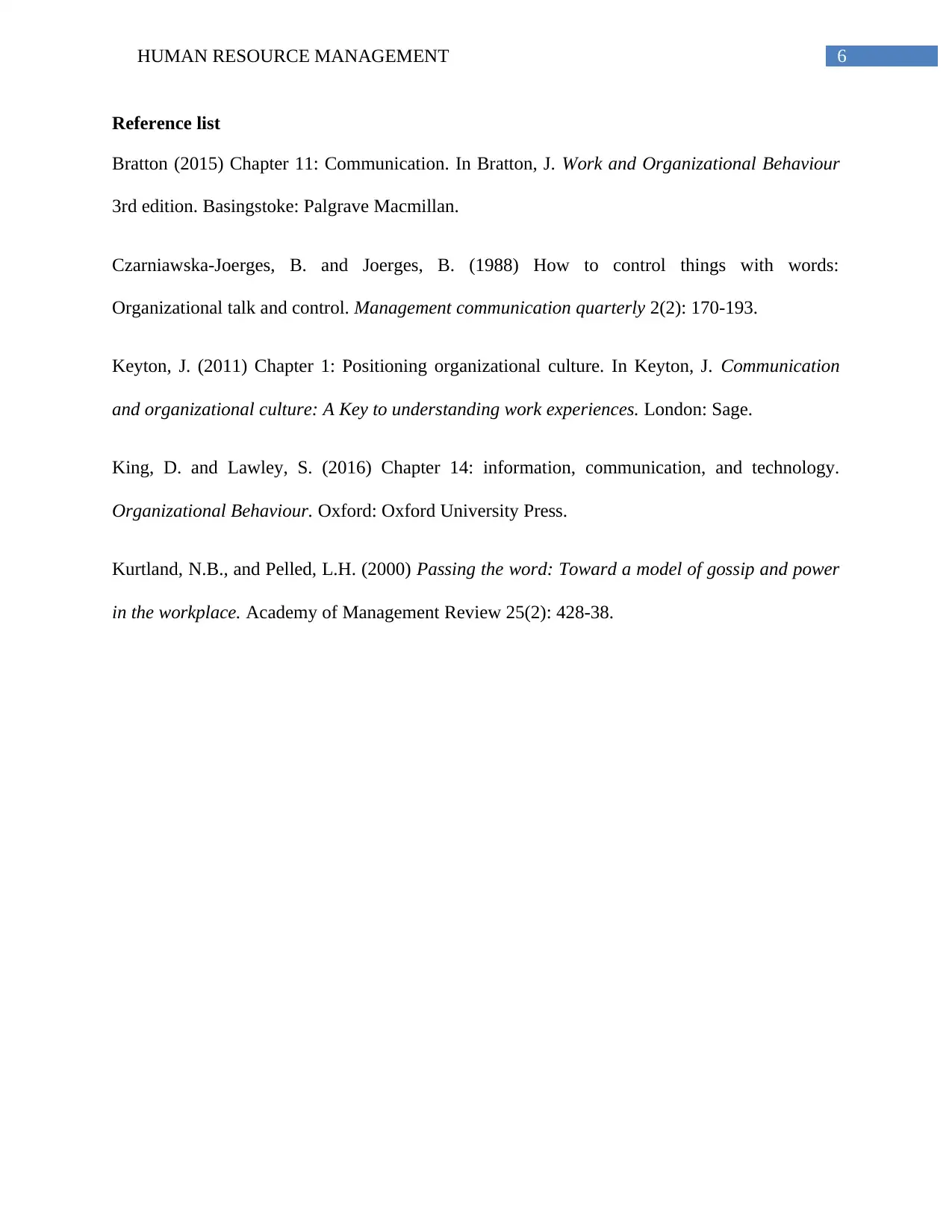
6HUMAN RESOURCE MANAGEMENT
Reference list
Bratton (2015) Chapter 11: Communication. In Bratton, J. Work and Organizational Behaviour
3rd edition. Basingstoke: Palgrave Macmillan.
Czarniawska-Joerges, B. and Joerges, B. (1988) How to control things with words:
Organizational talk and control. Management communication quarterly 2(2): 170-193.
Keyton, J. (2011) Chapter 1: Positioning organizational culture. In Keyton, J. Communication
and organizational culture: A Key to understanding work experiences. London: Sage.
King, D. and Lawley, S. (2016) Chapter 14: information, communication, and technology.
Organizational Behaviour. Oxford: Oxford University Press.
Kurtland, N.B., and Pelled, L.H. (2000) Passing the word: Toward a model of gossip and power
in the workplace. Academy of Management Review 25(2): 428-38.
Reference list
Bratton (2015) Chapter 11: Communication. In Bratton, J. Work and Organizational Behaviour
3rd edition. Basingstoke: Palgrave Macmillan.
Czarniawska-Joerges, B. and Joerges, B. (1988) How to control things with words:
Organizational talk and control. Management communication quarterly 2(2): 170-193.
Keyton, J. (2011) Chapter 1: Positioning organizational culture. In Keyton, J. Communication
and organizational culture: A Key to understanding work experiences. London: Sage.
King, D. and Lawley, S. (2016) Chapter 14: information, communication, and technology.
Organizational Behaviour. Oxford: Oxford University Press.
Kurtland, N.B., and Pelled, L.H. (2000) Passing the word: Toward a model of gossip and power
in the workplace. Academy of Management Review 25(2): 428-38.
1 out of 7
Related Documents
Your All-in-One AI-Powered Toolkit for Academic Success.
+13062052269
info@desklib.com
Available 24*7 on WhatsApp / Email
![[object Object]](/_next/static/media/star-bottom.7253800d.svg)
Unlock your academic potential
Copyright © 2020–2025 A2Z Services. All Rights Reserved. Developed and managed by ZUCOL.





